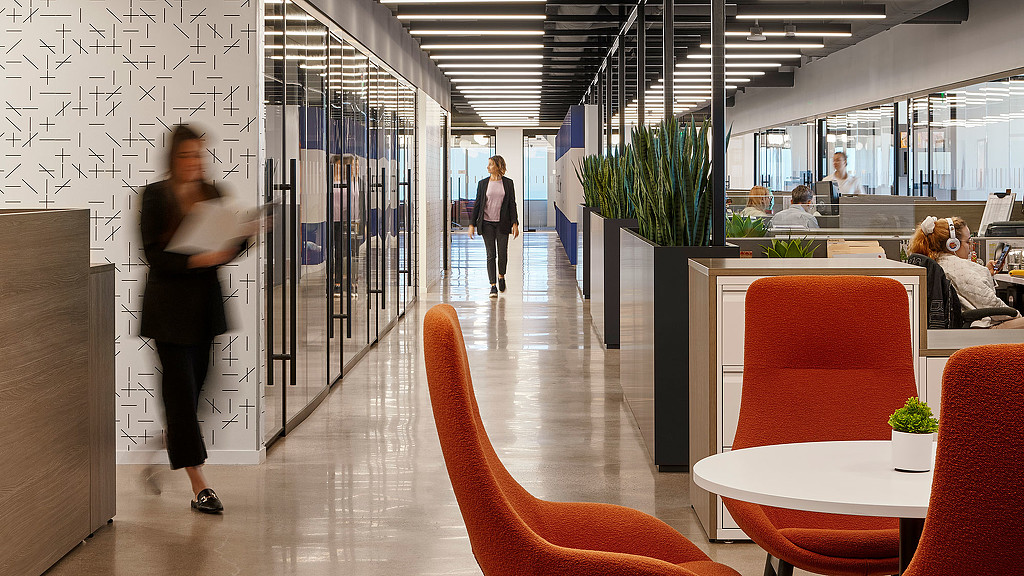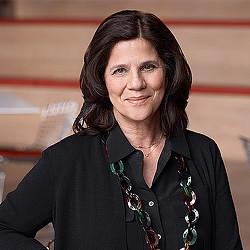Evolution of the Legal Workplace
July 05, 2023 | By Barbara Dunn
Editor's Note: this piece was originally published in the July/August 2023 issue of the American Bar Association's Law Practice Magazine, The Big Ideas Issue.
Work is what you do, not where you do it. The pandemic was a wake-up call that accelerated changes in space design that had been brewing in recent years. Without a clear path forward, space solutions range from traditional assigned offices to shared offices reserved for the day. Attendance requirements vary from no mandate to two to three days per week required.
Firms took advantage of high vacancy rates and market uncertainty to restructure their leases and give back space. With the rise in flexible attendance and increased reliance on technology, firms experienced up to a 20% reduction in square footage. The focus now needs to extend beyond saving overhead and achieving efficient real estate footprints to include the impact and effectiveness of the workplace. Firms need to intentionally plan the desired outcomes for collaboration, productivity, and culture.
Law firms, like most high-performing companies, want people back in the office. A recent Gensler Research survey found that people do want to come back to the office more frequently, but only if the workplace offers the right experience.
One of the top reasons to come into the office is to focus on work and maximize individual productivity — a shift from data collected during the pandemic that placed greater emphasis on working in-person with colleagues. Other top reasons to return to the office center around intentional-based activities such as scheduled meetings and access to technology, specific spaces, materials, and resources.
Generation Z seeks to be in the office more often than other generations, primarily to take advantage of pent-up demand for learning and career development opportunities.
Workers crave — actually expect — a diverse mix of workspaces, from work cafes to boutique hotel-like spaces. Well-designed, high-performing workplaces contribute to personal well-being, career advancement and job satisfaction. Besides being a critical tool for talent attraction and retention, a great space entices people to work in the office more regularly.
During the pandemic, firms realized that lawyers can be productive no matter where they work. They now also recognize the importance of physical interaction to build culture and grow business. Defining real estate needs to support culture involves the complex analysis of determining who will be in the office, how frequently and more importantly, for what purpose. The resulting road map will influence not only the physical footprint but also the firm’s culture and performance, attorney, and staff engagement and, of course, the bottom line.
Legal industry workers want a residential yet professional atmosphere. Consistently, ideal work environment descriptors include comfortable, bright, and collaborative, with acoustically private spaces to work.
Adopting New Ways of Working
People miss the social aspect of being in the office. Firms need to develop planned activities and programs that connect people and build culture and camaraderie, supported by the right types of spaces.
Law firms have long recognized the need for spaces where undistracted, individual focus work can occur but not the companion need for collaborative settings. A 2019 Gensler Research survey found that the most effective workplaces balance focus and collaboration, and this still holds true.
As incentives including slicker technology, schedule flexibility, challenging work, bonus compensation and well-appointed workspace replace the importance of “the big corner office,” firms are leveraging smaller, universal-sized offices for all attorneys. With less space dedicated to private offices the opportunity arises for greater allocation of shared spaces that help people connect. Alternative work settings give employees a choice of spaces for different activities and accommodate peak utilization days.
An approach to planning that stresses flexibility and the use of spaces for multiple purposes is key. Aside from working from home, employees should also be able to work anywhere in the office. Flexibility coupled with the success of remote work has resulted in some firms moving support functions to less expensive real estate or encouraging fully remote positions. The advantage is that firms can cast a wider net to find the best talent.
IT solutions that support remote work and mobility and deliver a seamless and robust work experience both on and off-site are essential to good design and allow firms to maximize the ways space is used.
The Role of Firm Culture
To encourage connection, firms should incorporate residential comfort and hospitality-design elements, providing opportunities for casual interaction, networking, cross-selling and building trust that are so critical in a partnership.
The office needs to support interactions that do not work well remotely. By providing open spaces with fewer walls dividing the workplace, the opportunity for impromptu learning, mentoring, and socializing improves. Collaboration and interaction allow employees to connect and put faces to names and build relationships. Glass-fronted offices and open workplaces convey a greater sense of accessibility than long corridors with solid walls and closed doors. People get energized and inspired seeing their colleagues working and clients meeting.
The passions and concerns of firm leaders and employees drive culture. Climate and the environment, equality and diversity, and health and well-being are now all elements of thoughtful workplace design. They are manifested in physical amenities like accessible and inclusive design, sustainable environments sourcing local products with net-zero carbon emissions and spaces that invite community engagement. Complementing the physical are policies such as anti-bias initiatives and the freedom to work where and when you are most productive.
The accelerated focus on health and wellness in the workplace has expanded to incorporate quiet or mindfulness rooms, gender-neutral restrooms, good air quality, access to outdoor spaces and biophilic design elements like green walls and plants that create a connection to nature. Beyond the private office, social spaces, lounges, and outdoor terraces are an extension of the workplace that encourage casual collisions and knit people together.
Private offices are not going away. Legal industry workers still spend more time at their desk and more time working alone, and trend toward assigned seating as compared to the U.S. average.
Tips for Rethinking the Office
Isn’t hybrid work just the next iteration of telecommuting for an increasingly mobile, tech-enabled workforce? With client and team meetings, vacations, sick days, taking kids to the doctor or soccer, you might discover that the number of empty seats in 2019 is not that different than today’s statistics.
Develop a strategic approach. Identify what the firm wants to accomplish as a business entity and how its real estate investment could support those goals. Engage attorneys and staff in the process of conceiving and designing the future space. Use surveys, focus groups, and town hall meetings to uncover:
- compelling trends in the legal industry that may impact your work process and workspaces;
- primary business objectives, opportunities and challenges;
- organizational priorities and directions for the future; and
- success measures.
Build consensus. The ideal office has a bit of something for everyone, recognizing that each person works differently. Establish a small design committee charged with guiding decisions about planning and design, functioning as ambassadors to the firm, soliciting feedback and generating excitement for innovative approaches to the work environment.
Embrace hospitality-influenced design. A comfortable, more relaxed environment can reshape the work experience. View both clients and employees as valued guests. Provide resources that help people to transition to the office again. For firms using hot-desking (non-assigned seating), an uplifting arrival space coupled with the ease to grab a coffee or snack, a locker to store personal belongings and a concierge to facilitate seating make the days seamless and enjoyable.
Create a clubhouse. Morph the staff lunchroom or attorney-only lounge into a shared venue that functions for all parties as a place to get caffeinated, catch up with colleagues, grab lunch at a fresh food marketplace or meet your team at a cozy booth equipped with a monitor to review documents.
Respect differences. Employee work experience preferences vary based upon their role, commute, and life stage. Flexible choices that support individual preferences to work in the way that is best for them fosters a strong work culture of inclusivity.
Manage your footprint. Firms are not warehousing space for the future; instead, growth can be managed through alternative work settings and reliance on hybrid schedules. Plan the initial space with no more than one-to-one seating for lawyer offices and accommodate growth by sharing alternative workspaces or offices.
Reinforce being there. Make the office a destination, not an obligation. Use the office as a catalyst for collaborative work and building social relationships. While some find the home is better than the office for focus work, legal offices are still essential for socializing, mentoring, and reinforcing firm culture.
Promote Your Culture
Effective collaborative work is at a low point. People are in the office on conference calls but each at their own desk rather than feeding off the energy and seeing the nuanced reactions that occur when they experience the call in a shared room. Everyone, not just new employees, is missing the connection to experienced co-workers.
People make the office a worthwhile experience. Take charge of organizing activities and events to make in-person interaction more personally rewarding. These activities may include arranging a social hour or all-employee lunches, hosting an outside speaker, or encouraging group continuing education activities. A monthly newsletter featuring team accomplishments, sharing milestones or information about social activities might resonate in your firm. After identifying which activities resonate, make them traditions to enhance your workplace culture.
Key Considerations
People want a work environment in which they feel engaged and invigorated connecting with their colleagues, they want to know that anyone can openly share their thoughts and ideas without reprisal, and they want to see their positive impact on their organization.
Set clear policies. Be transparent when messaging expectations for in-office attendance. Understand that it may be perceived unfair to have a double standard for lawyers and staff or senior attorneys and associates.
Avoid the office as a ghost town. It is discouraging to come into the office and not see colleagues. Have groups come in on the same day(s) to encourage a spirited office and opportunity for synergies.
Gather opinions and data. Stakeholders bring diverse perspectives to guide and influence what spaces and tools are needed to support their work. Analyze data around how people are using space to anticipate future demand. Research and benchmark innovative concepts from different industries that may allow for a novel approach to your office space.
Create a sense of place. The future of workplace emphasizes spaces that promote richer experiences and can extend beyond the walls of your suite. Consider the benefits that a building might offer to augment your employee experience. Landlord amenities can support some of your firm’s needs for a conference or event center, rooftop garden, terrace or courtyard to create a sense of neighborhood. Experiment and adapt. It is challenging to predict how the workplace will continue to change. However, as a leader you need to forge ahead or be left behind. Create an adaptable framework, test different solutions, and embrace experimentation.
Engage a consultant. A strategic partner can help drive real estate decisions that will best support your firm’s talent through design choices and location strategies. An architect or workplace strategist can serve as a valuable outside facilitator offering in-depth insight on office design and knowledge of peer firm solutions. As an outside party, they can clarify how the firm works today and how you would like to work in the future, specifically pertaining to collaboration, communication, and innovation.
Firm leaders are wrestling to balance what works for their people and what works for their business. It takes leadership to get people back in the office. To achieve engagement and energize the office attorneys need to show up. Give them an office environment with features and activities that are not available at home. Make the workplace the “hearth” for the firm.
For media inquiries, email .

